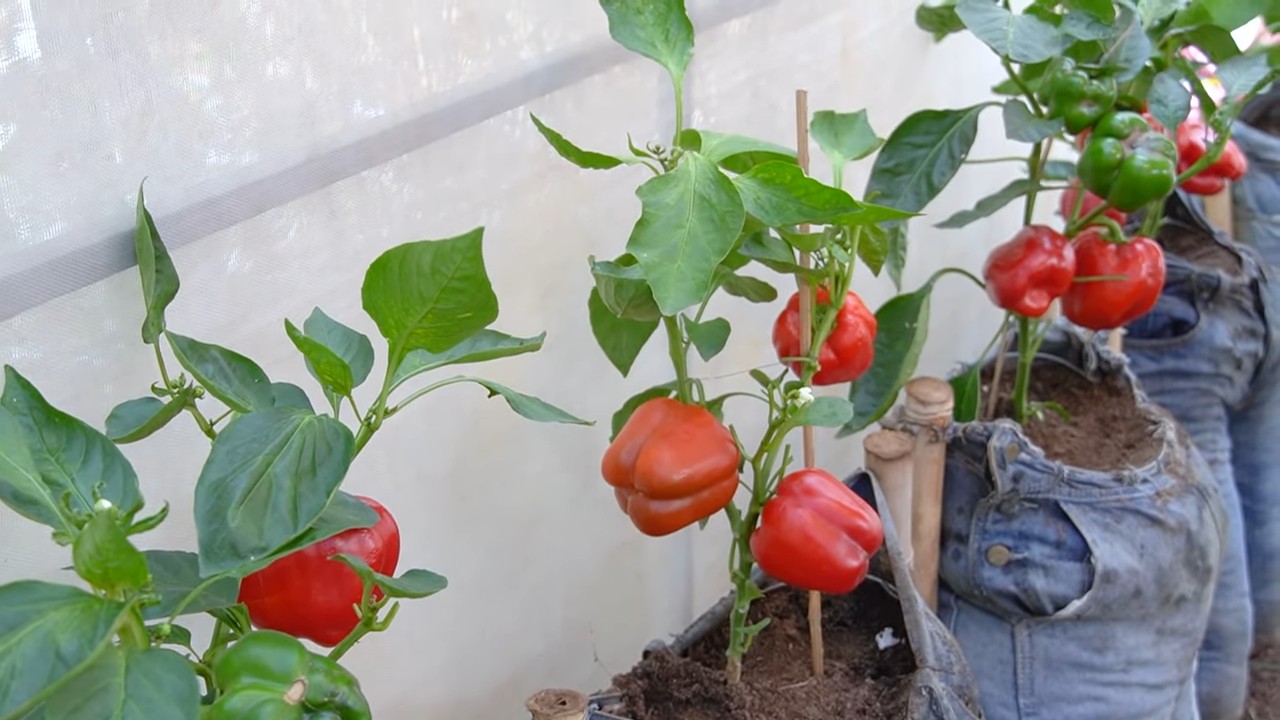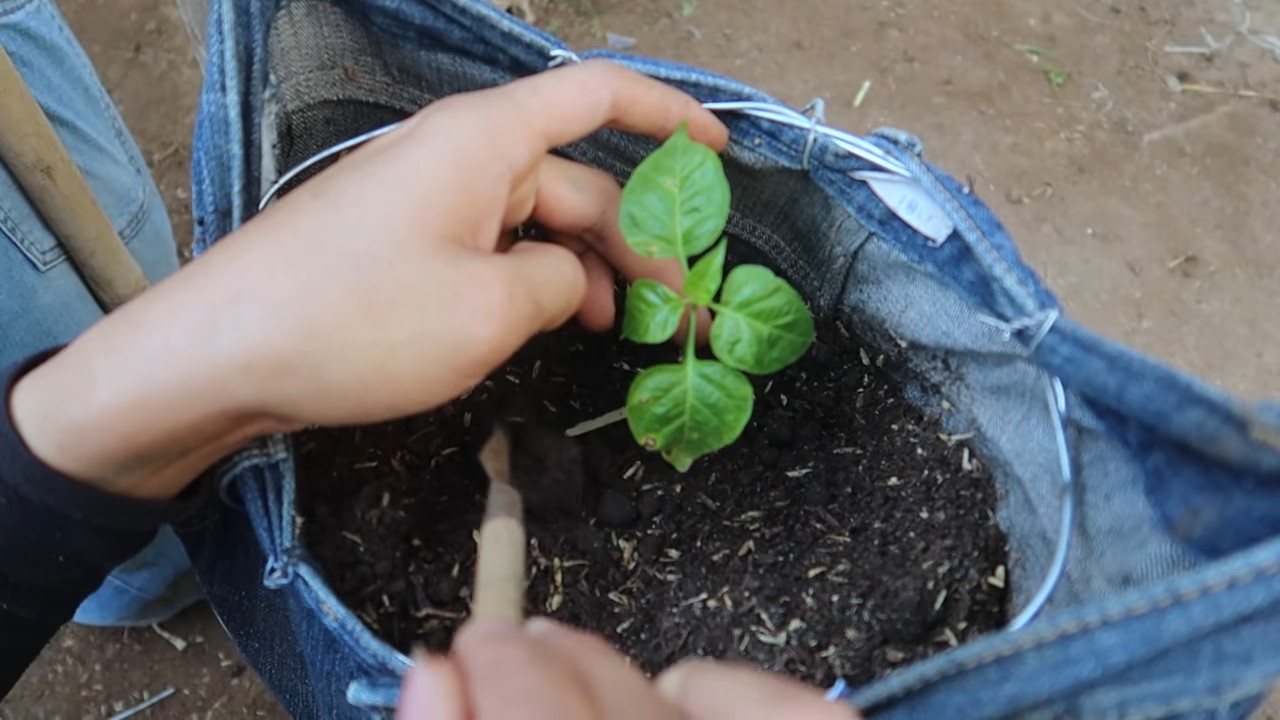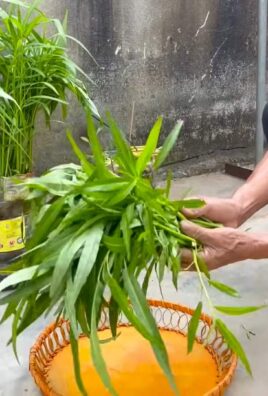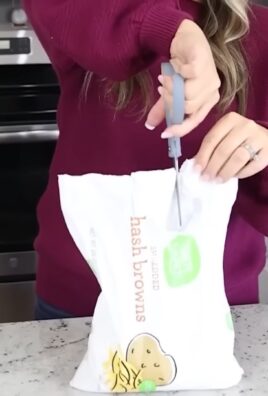Jeans for Pepper Plant Support: Who knew your old denim could be the secret weapon to a thriving pepper patch? Let’s face it, we’ve all got that pile of jeans lurking in the back of our closets – the ones we can’t quite bear to part with, even though they’re ripped, faded, or just plain out of style. But before you relegate them to the donation bin, consider this: they could be the unexpected heroes your pepper plants have been waiting for!
For centuries, gardeners have relied on ingenuity and resourcefulness to nurture their crops. While the history of using denim specifically for plant support might not be ancient, the spirit of repurposing and finding creative solutions in the garden is as old as agriculture itself. Think about it – from using eggshells to enrich the soil to crafting scarecrows from old clothes, gardeners have always been masters of DIY.
Why do you need this particular DIY trick? Well, pepper plants, especially when laden with fruit, can become top-heavy and prone to snapping. Traditional stakes can be unsightly and sometimes even damage the delicate stems. That’s where your old jeans come in! They offer a soft, flexible, and surprisingly strong support system that blends seamlessly into your garden. Plus, it’s a fantastic way to reduce waste and give those forgotten jeans a new lease on life. I’m excited to show you how to transform those old jeans into a stylish and functional support system, ensuring your pepper plants stand tall and produce a bountiful harvest. Let’s get started!

Upcycling Your Old Jeans into Stylish Pepper Plant Supports
Hey there, fellow gardening enthusiasts! Are your pepper plants getting a little droopy under the weight of all those delicious peppers? Are you looking for a sustainable and stylish way to give them some support? Well, look no further! Today, I’m going to show you how to transform your old jeans into unique and sturdy pepper plant supports. This is a fantastic way to recycle, add a touch of personality to your garden, and, most importantly, help your pepper plants thrive. Let’s get started!
What You’ll Need
Before we dive in, let’s gather our supplies. This project is super budget-friendly, relying mostly on items you probably already have around the house.
* Old Jeans: The sturdier the denim, the better! Look for jeans that are too worn to wear but still have some life left in the fabric.
* Scissors or Rotary Cutter: For cutting the denim into strips. A rotary cutter and cutting mat will make the process faster and more precise, but scissors work just fine.
* Measuring Tape or Ruler: To ensure consistent strip widths.
* Sewing Machine (Optional): While you can hand-sew this project, a sewing machine will make it much faster and more durable.
* Thread: Choose a thread color that complements your denim.
* Sewing Needle (if hand-sewing): A sturdy needle designed for denim is recommended.
* Pins or Clips: To hold the denim strips in place while sewing.
* Wooden Dowels or Bamboo Stakes: These will form the main support structure. The length will depend on the size of your pepper plants. I usually go for 3-4 feet.
* Drill (Optional): If you want to create holes in the dowels for added stability.
* Twine or Garden Ties: To secure the denim supports to the dowels.
* Gloves: To protect your hands, especially if you’re working with thorny pepper plants.
* Safety Glasses: To protect your eyes when drilling.
Preparing the Denim Strips
This is where the transformation begins! We’re going to turn those old jeans into usable strips of denim.
1. Cut off the Legs: Lay your jeans flat and carefully cut off both legs, just below the pockets. We’ll be using the legs for this project.
2. Open the Seams: Use your scissors or seam ripper to open up the inseam and outseam of each leg. This will give you two large pieces of denim to work with.
3. Cut into Strips: Now, the fun part! Using your measuring tape or ruler as a guide, cut the denim into strips. I recommend strips that are about 2-3 inches wide. The width is really up to you and the look you’re going for. Wider strips will be sturdier, while narrower strips will be more flexible.
* Tip: If you want a more rustic look, don’t worry about making the strips perfectly even. Slight variations in width will add character.
4. Iron the Strips (Optional): Ironing the strips will make them easier to work with, especially if you’re planning on sewing them. This step is optional, but I find it helps create a neater finished product.
Creating the Denim Support Structures
Now that we have our denim strips, let’s start building the actual supports. There are a few different ways you can approach this, so I’ll outline a couple of my favorite methods.
Method 1: The Denim Cage
This method creates a cage-like structure around the pepper plant, providing support from all sides.
1. Determine the Height: Decide how tall you want your denim cage to be. This will depend on the size of your pepper plant and how much support it needs.
2. Cut the Dowels: Cut your wooden dowels or bamboo stakes to the desired height. You’ll need at least three dowels for each plant.
3. Create the Base: Arrange the dowels in a triangle or square around the base of your pepper plant. Make sure the dowels are spaced evenly apart.
4. Sew the Denim Strips Together: Take your denim strips and sew them together end-to-end to create one long strip. The length of the strip will depend on the size of your cage.
5. Wrap the Dowels: Starting at the base of the dowels, wrap the denim strip around them, weaving it in and out to create a cage-like structure.
6. Secure the Denim: As you wrap, use pins or clips to hold the denim in place. Once you’re happy with the shape of the cage, sew the denim strip to itself at various points to secure it. You can also use twine or garden ties to secure the denim to the dowels.
7. Reinforce the Structure (Optional): For added stability, you can drill holes through the dowels and thread twine or wire through the holes to further secure the denim.
Method 2: The Denim Sling
This method creates individual slings that support the branches of your pepper plant.
1. Determine the Sling Length: Decide how long you want your denim slings to be. This will depend on the size of your pepper plant’s branches.
2. Cut the Denim Strips: Cut your denim strips to the desired length. You’ll need one strip for each branch you want to support.
3. Fold and Sew the Strips: Fold each denim strip in half lengthwise and sew along the open edge to create a tube. This will make the sling stronger and more durable.
4. Attach to Dowels: Cut your dowels to a suitable height for supporting the branches. Position the dowels near the plant.
5. Create Loops: Sew the ends of each denim tube together to form a loop.
Hey there, fellow gardening enthusiasts! Are your pepper plants getting a little droopy under the weight of all those delicious peppers? Are you looking for a sustainable and stylish way to give them some support? Well, look no further! Today, I’m going to show you how to transform your old jeans into unique and sturdy pepper plant supports. This is a fantastic way to recycle, add a touch of personality to your garden, and, most importantly, help your pepper plants thrive. Let’s get started!
What You’ll Need
Before we dive in, let’s gather our supplies. This project is super budget-friendly, relying mostly on items you probably already have around the house.
* Old Jeans: The sturdier the denim, the better! Look for jeans that are too worn to wear but still have some life left in the fabric.
* Scissors or Rotary Cutter: For cutting the denim into strips. A rotary cutter and cutting mat will make the process faster and more precise, but scissors work just fine.
* Measuring Tape or Ruler: To ensure consistent strip widths.
* Sewing Machine (Optional): While you can hand-sew this project, a sewing machine will make it much faster and more durable.
* Thread: Choose a thread color that complements your denim.
* Sewing Needle (if hand-sewing): A sturdy needle designed for denim is recommended.
* Pins or Clips: To hold the denim strips in place while sewing.
* Wooden Dowels or Bamboo Stakes: These will form the main support structure. The length will depend on the size of your pepper plants. I usually go for 3-4 feet.
* Drill (Optional): If you want to create holes in the dowels for added stability.
* Twine or Garden Ties: To secure the denim supports to the dowels.
* Gloves: To protect your hands, especially if you’re working with thorny pepper plants.
* Safety Glasses: To protect your eyes when drilling.
Preparing the Denim Strips
This is where the transformation begins! We’re going to turn those old jeans into usable strips of denim.
1. Cut off the Legs: Lay your jeans flat and carefully cut off both legs, just below the pockets. We’ll be using the legs for this project.
2. Open the Seams: Use your scissors or seam ripper to open up the inseam and outseam of each leg. This will give you two large pieces of denim to work with.
3. Cut into Strips: Now, the fun part! Using your measuring tape or ruler as a guide, cut the denim into strips. I recommend strips that are about 2-3 inches wide. The width is really up to you and the look you’re going for. Wider strips will be sturdier, while narrower strips will be more flexible.
* Tip: If you want a more rustic look, don’t worry about making the strips perfectly even. Slight variations in width will add character.
4. Iron the Strips (Optional): Ironing the strips will make them easier to work with, especially if you’re planning on sewing them. This step is optional, but I find it helps create a neater finished product.
Creating the Denim Support Structures
Now that we have our denim strips, let’s start building the actual supports. There are a few different ways you can approach this, so I’ll outline a couple of my favorite methods.
Method 1: The Denim Cage
This method creates a cage-like structure around the pepper plant, providing support from all sides.
1. Determine the Height: Decide how tall you want your denim cage to be. This will depend on the size of your pepper plant and how much support it needs.
2. Cut the Dowels: Cut your wooden dowels or bamboo stakes to the desired height. You’ll need at least three dowels for each plant.
3. Create the Base: Arrange the dowels in a triangle or square around the base of your pepper plant. Make sure the dowels are spaced evenly apart.
4. Sew the Denim Strips Together: Take your denim strips and sew them together end-to-end to create one long strip. The length of the strip will depend on the size of your cage.
5. Wrap the Dowels: Starting at the base of the dowels, wrap the denim strip around them, weaving it in and out to create a cage-like structure.
6. Secure the Denim: As you wrap, use pins or clips to hold the denim in place. Once you’re happy with the shape of the cage, sew the denim strip to itself at various points to secure it. You can also use twine or garden ties to secure the denim to the dowels.
7. Reinforce the Structure (Optional): For added stability, you can drill holes through the dowels and thread twine or wire through the holes to further secure the denim.
Method 2: The Denim Sling
This method creates individual slings that support the branches of your pepper plant.
1. Determine the Sling Length: Decide how long you want your denim slings to be. This will depend on the size of your pepper plant’s branches.
2. Cut the Denim Strips: Cut your denim strips to the desired length. You’ll need one strip for each branch you want to support.
3. Fold and Sew the Strips: Fold each denim strip in half lengthwise and sew along the open edge to create a tube. This will make the sling stronger and more durable.
4. Attach to Dowels: Cut your dowels to a suitable height for supporting the branches. Position the dowels near the plant.
5. Create Loops: Sew the ends of each denim tube together to form a loop.
6. Secure the Slings: Place the denim loops around the branches of your pepper plant, positioning them so that they provide support without constricting the plant. Use twine or garden ties to secure the slings to the dowels.
7. Adjust as Needed: As your pepper plant grows, you may need to adjust the position of the slings to provide continued support.
Adding the Finishing Touches
Once you’ve created your denim supports, it’s time to add the finishing touches.
1. Position the Supports: Carefully position the denim supports around your pepper plants, making sure they are stable and secure.
2. Secure to the Ground: If necessary, you can use garden stakes or rocks to further secure the supports to the ground.
3. Adjust as Needed: As your pepper plants grow and produce more peppers, you may need to adjust the supports to provide additional support.
4. Admire Your Work: Step back and admire your handiwork! You’ve successfully upcycled your old jeans into stylish and functional pepper plant supports.
Tips and Tricks for Success
Here are a few extra tips to help you get the most out of this project:
* Choose the Right Denim: Sturdy denim is key for creating durable supports. Avoid using denim that is too thin or worn.
* Experiment with Different Designs: Don’t be afraid to get creative with your designs! You can try different weaving patterns, add embellishments, or even dye the denim to create a unique look.
* Consider the Plant’s Needs: When designing your supports, keep in mind the specific needs of your pepper plants. Some varieties may require more support than others.
* Monitor Your Plants: Keep an eye on your pepper plants to make sure the supports are providing adequate support and not constricting their growth.
* Don’t Be Afraid to Adjust: Gardening is all about experimentation! If something isn’t working, don’t be afraid to adjust your approach.
Why This Project Rocks
I love this DIY project for so many reasons:
* It’s Sustainable: Upcycling old jeans is a great way to reduce waste and give new life to something that would otherwise end up in the landfill.
* It’s Budget-Friendly: This project relies mostly on materials you already have around the house, making it a very affordable way to support your pepper plants.
* It’s Customizable: You can customize the design of your denim supports to match your personal style and the needs of your garden.
* It’s Functional: Most importantly, this project provides much-needed support for your pepper plants, helping them to thrive and produce a bountiful harvest.
So, there you have it! A complete guide to upcycling your old jeans into stylish and functional pepper plant supports. I hope you enjoy this project as much as I do. Happy gardening!

Conclusion
So, there you have it! Transforming your old jeans into sturdy and stylish supports for your pepper plants is not just a clever upcycling project; it’s a game-changer for your garden. We’ve explored how this simple DIY trick can provide robust support, prevent stem breakage, and even add a touch of rustic charm to your vegetable patch.
Why is this a must-try? Because it’s sustainable, cost-effective, and incredibly easy. Instead of spending money on flimsy, mass-produced plant supports that might not even last a season, you’re giving new life to something you already own. You’re reducing waste, saving money, and creating a healthier environment for your pepper plants to thrive. Plus, let’s be honest, those store-bought supports just don’t have the same character as a repurposed pair of jeans!
But the beauty of this DIY project lies in its adaptability. Feel free to experiment with different jean washes and styles to match your garden’s aesthetic. Consider braiding the denim strips for added strength and visual appeal. You could even dye the denim different colors to create a vibrant and eye-catching support system. For smaller pepper plants, try using the pockets as little pouches to hold extra soil or slow-release fertilizer. Get creative and personalize your supports to reflect your unique gardening style.
Don’t limit yourself to just pepper plants! This technique works wonders for tomatoes, eggplants, cucumbers, and any other vining or top-heavy plants that need a little extra support. The possibilities are endless!
We truly believe that this jeans for pepper plant support method is a win-win for both you and your garden. It’s a practical solution to a common gardening problem, a creative way to upcycle, and a fun project that anyone can tackle.
So, what are you waiting for? Dig out those old jeans, grab your scissors, and get ready to transform your garden! We’re confident that you’ll be amazed by the results.
And most importantly, we want to hear about your experience! Share your photos, tips, and variations in the comments below. Let’s inspire each other to create beautiful and sustainable gardens, one pair of repurposed jeans at a time. Happy gardening!
Frequently Asked Questions (FAQ)
1. What kind of jeans work best for pepper plant supports?
Almost any type of jeans can be used, but heavier denim tends to provide more robust support. Sturdier jeans like those made from raw denim or workwear denim will hold up better over time, especially in harsh weather conditions. However, lighter-weight jeans can also be used, particularly for smaller pepper plants or for creating more flexible supports. Consider the size and weight of your pepper plants when choosing your denim. Jeans with minimal stretch are generally preferable, as they will maintain their shape better under the weight of the plants.
2. How do I prevent the denim from rotting or attracting pests?
While denim is relatively durable, it’s a good idea to take steps to prevent rot and pest infestations. Before using the denim, you can wash it with a natural, non-toxic detergent and add a cup of white vinegar to the rinse cycle. This will help to remove any lingering chemicals and deter pests. You can also treat the denim with a natural sealant, such as beeswax or linseed oil, to make it more water-resistant. Regularly inspect the denim supports for signs of rot or pest activity. If you notice any problems, remove the affected denim and replace it with fresh material. Good garden hygiene, such as removing fallen leaves and debris, can also help to prevent pest problems.
3. Can I use colored or patterned jeans?
Absolutely! Colored or patterned jeans can add a fun and unique touch to your garden. Just be aware that some dyes may fade over time when exposed to sunlight and rain. If you’re concerned about fading, you can choose jeans made with colorfast dyes or apply a UV protectant spray to the denim. Consider the overall aesthetic of your garden when choosing colored or patterned jeans. You might want to coordinate the colors with your flowers or other garden decorations.
4. How do I attach the denim supports to the pepper plants?
There are several ways to attach the denim supports to your pepper plants. One simple method is to tie the denim strips loosely around the stems of the plants, using a figure-eight knot to prevent the denim from cutting into the stems. You can also use garden twine or soft plant ties to secure the denim to the plants. For larger pepper plants, you might want to create a more elaborate support system using multiple denim strips and stakes. Be sure to leave enough room for the plants to grow and avoid tying the denim too tightly, as this can restrict growth and damage the stems.
5. How long will the denim supports last?
The lifespan of your denim supports will depend on several factors, including the quality of the denim, the weather conditions, and how well you maintain them. In general, you can expect the supports to last for at least one growing season, and possibly longer if you take good care of them. Regularly inspect the denim for signs of wear and tear, and replace it as needed. You can also extend the lifespan of the supports by storing them indoors during the off-season.
6. Can I compost the denim after I’m done using it?
Yes, denim is compostable, but it’s important to prepare it properly first. Remove any metal parts, such as zippers and buttons, as these will not decompose. Cut the denim into small pieces to speed up the composting process. Denim is primarily made of cotton, which is a good source of carbon for your compost pile. However, it’s important to balance the carbon with nitrogen-rich materials, such as grass clippings and vegetable scraps, to ensure proper decomposition.
7. What are some other creative ways to use old jeans in the garden?
Besides using them for pepper plant supports, there are many other creative ways to repurpose old jeans in the garden. You can use them to create raised garden beds, hanging planters, or even scarecrows. The pockets can be used as small planters for herbs or succulents. You can also cut the denim into strips and use them as mulch to suppress weeds and retain moisture in the soil. Let your imagination run wild and see what other innovative ways you can find to give your old jeans a new life in the garden!
8. Is using jeans for pepper plant support safe for organic gardening?
Generally, yes, using jeans for pepper plant support is safe for organic gardening, especially if the jeans are made from natural fibers like cotton and haven’t been treated with harsh chemicals. However, it’s always a good idea to check the label of your jeans to ensure they don’t contain any synthetic materials or harmful dyes. If you’re unsure, you can wash the jeans thoroughly before using them in your garden to remove any potential residues. Opting for organic denim or vintage jeans is an even safer bet for maintaining a truly organic garden.




Leave a Comment